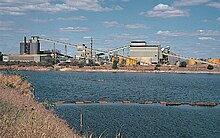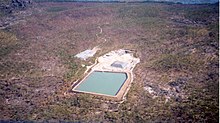
Kakadu National Park is a protected area in the Northern Territory of Australia, 171 km (106 mi) southeast of Darwin. It is a World Heritage Site. Kakadu is also gazetted as a locality, covering the same area as the national park, with 313 people recorded living there in the 2016 Australian census.

Jabiluka is a pair of uranium deposits and mine development in the Northern Territory of Australia that was to have been built on land belonging to the Mirarr clan of Aboriginal people. The mine site is surrounded by, but not part of, the World Heritage–listed Kakadu National Park.

The Ranger Uranium Mine was a uranium mine in the Northern Territory of Australia. The site is surrounded by, but separate from Kakadu National Park, 230 km east of Darwin. The orebody was discovered in late 1969, and the mine commenced operation in 1980, reaching full production of uranium oxide in 1981 and ceased stockpile processing on 8 January 2021. Mining activities had ceased in 2012. It is owned and operated by Energy Resources of Australia (ERA), a public company 86.33% owned by Rio Tinto Group, the remainder held by the public. Uranium mined at Ranger was sold for use in nuclear power stations in Japan, South Korea, China, UK, France, Germany, Spain, Sweden and the United States.

The Australian Conservation Foundation (ACF) is Australia's national environmental organisation, launched in 1965 in response to a proposal by the World Wide Fund for Nature for a more co-ordinated approach to sustainability.
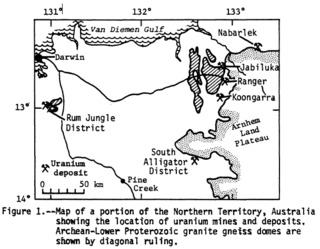
Alligator Rivers is the name of an area in an Arnhem Land region of the Northern Territory of Australia, containing three rivers, the East, West, and South Alligator Rivers. It is regarded as one of the richest biological regions in Australia, with part of the region in the Kakadu National Park. It is an Important Bird Area (IBA), lying to the east of the Adelaide and Mary River Floodplains IBA. It also contains mineral deposits, especially uranium, and the Ranger Uranium Mine is located there. The area is also rich in Australian Aboriginal art, with 1500 sites. The Kakadu National Park is one of the few World Heritage sites on the list because of both its natural and human heritage values. They were explored by Lieutenant Phillip Parker King in 1820, who named them in the mistaken belief that the crocodiles in the estuaries were alligators.
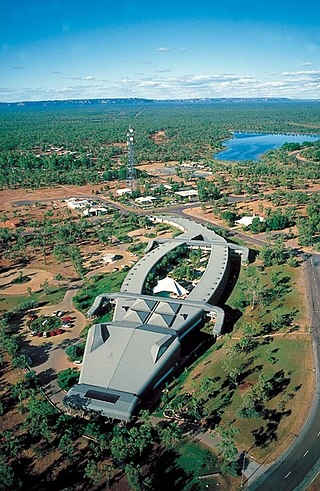
Jabiru is a town in the Northern Territory of Australia. Built in 1982, the town is completely surrounded by Kakadu National Park. At the 2016 census, Jabiru had a population of 1,081. It is named after the black-necked stork often seen in the wetlands and billabongs of Kakadu, which is commonly referred to in Australia as a Jabiru.

Energy Resources of Australia Ltd is a public company based in Australia. It is a subsidiary of the Rio Tinto Group which as of 2021 owns 86.3% of the company. The remainder is publicly held and traded on the Australian Securities Exchange. The chairman is Peter McMahon and Chief Executive is Andrea Sutton.
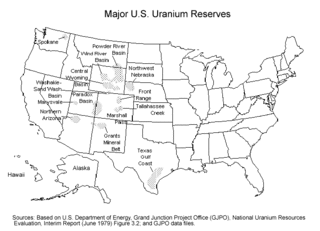
Uranium mining in the United States produced 173,875 pounds (78.9 tonnes) of U3O8 in 2019, 88% lower than the 2018 production of 1,447,945 pounds (656.8 tonnes) of U3O8 and the lowest US annual production since 1948. The 2019 production represents 0.3% of the anticipated uranium fuel requirements of the US's nuclear power reactors for the year.

Kevin Buzzacott, often referred to as Uncle Kev as an Aboriginal elder, is an Indigenous Australian from the Arabunna nation in northern South Australia. He has campaigned widely for cultural recognition, justice and land rights for Aboriginal people, and has initiated and led numerous campaigns including against uranium mining at Olympic Dam, South Australia on Kokatha land, and the exploitation of the water from the Great Artesian Basin.

Uranium mining in Arizona has taken place since 1918. Prior to the uranium boom of the late 1940s, uranium in Arizona was a byproduct of vanadium mining of the mineral carnotite.
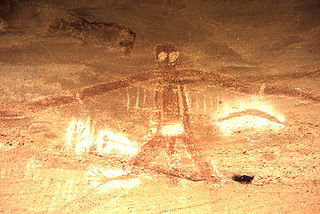
An Australian Aboriginal sacred site is a place deemed significant and meaningful by Aboriginal Australians based on their beliefs. It may include any feature in the landscape, and in coastal areas, these may lie underwater. The site's status is derived from an association with some aspect of social and cultural tradition, which is related to ancestral beings, collectively known as Dreamtime, who created both physical and social aspects of the world. The site may have its access restricted based on gender, clan or other Aboriginal grouping, or other factors.

Nuclear weapons testing, uranium mining and export, and nuclear power have often been the subject of public debate in Australia, and the anti-nuclear movement in Australia has a long history. Its origins date back to the 1972–1973 debate over French nuclear testing in the Pacific and the 1976–1977 debate about uranium mining in Australia.
Yvonne Margarula is an Aboriginal Australian environmentalist who won the 1998 Friends of the Earth International Environment Award and the 1998 Nuclear-Free Future Award. She also won the 1999 US Goldman Environmental Prize, with Jacqui Katona, in recognition of efforts to protect their country and culture against uranium mining.
Jacqui Katona is a western-educated Aboriginal Australian woman who led the campaign to stop the Jabiluka uranium mine in the Northern Territory. In 1998 the Mirrar Aboriginal people, together with environmental groups, used peaceful on-site civil disobedience to create one of the largest blockades in Australia's history. Katona won the 1999 U.S. Goldman Environmental Prize, with Yvonne Margarula, in recognition of efforts to protect their country and culture against uranium mining.
The Supervising Scientist is a statutory office under Australian law, originally created to assist in the monitoring of what was then one of the world's largest uranium mines, the Ranger Uranium Mine. It now provides advice more generally on a 'wide range of scientific matters and mining-related environmental issues of national importance, including; radiological matters and tropical wetlands conservation and management'. The Supervising Scientist is administered as a division within the Department of the Environment, Water, Heritage and the Arts.
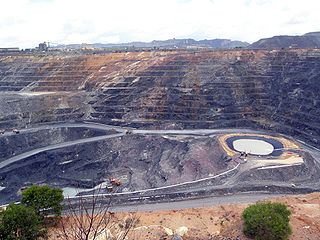
Radioactive ores were first extracted in South Australia at Radium Hill in 1906 and Mount Painter in 1911. 2,000 tons of ore were treated to recover radium for medical use. Several hundred kilograms of uranium were also produced for use in ceramic glazes.

The uranium mining debate covers the political and environmental controversies of the mining of uranium for use in either nuclear power or nuclear weapons.
The world's largest producer of uranium is Kazakhstan, which in 2019 produced 43% of the world's mining output. Canada was the next largest producer with a 13% share, followed by Australia with 12%. Uranium has been mined in every continent except Antarctica.
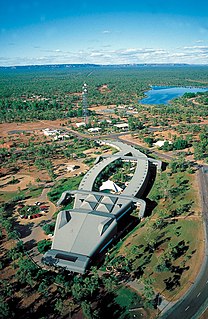
The Gagudju Crocodile Hotel, also known as Kakadu Crocodile Hotel or just the Croc Hotel is a 3.5 star hotel located in Jabiru, Northern Territory, within Australia's Kakadu National Park. Owned by the Indigenous clans of the Gaagudju people, it was the first major tourism development in the National Park and is notable for its unique design in the shape of a crocodile. Since 2014, the hotel has been operated by the Accor group under the Mecure brand.

